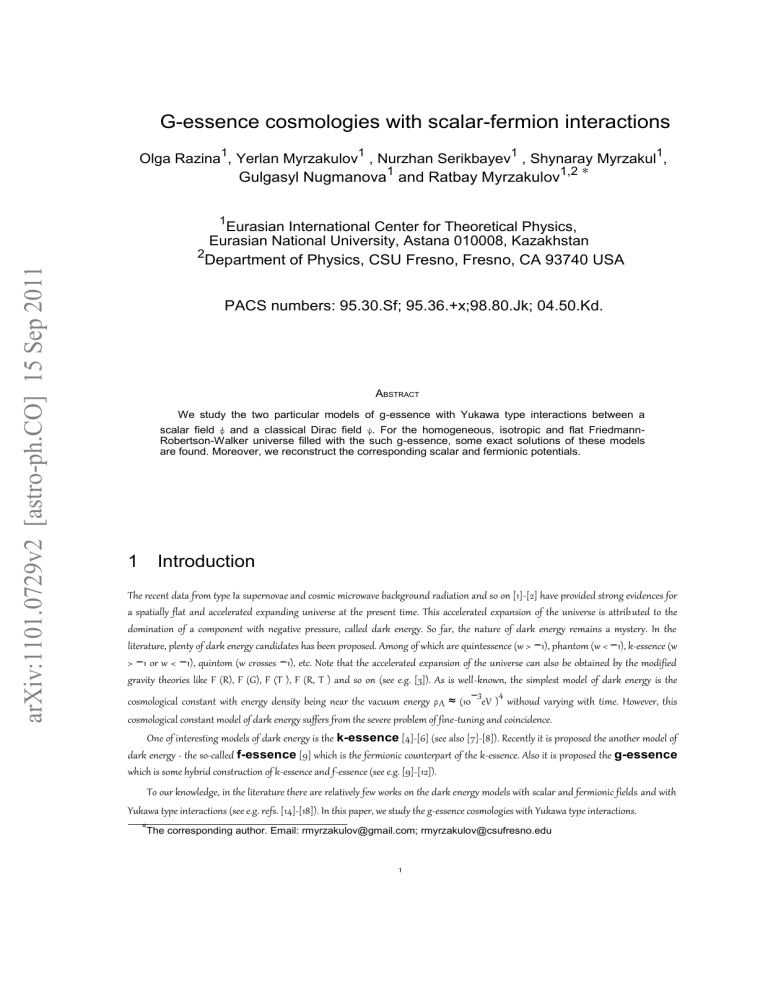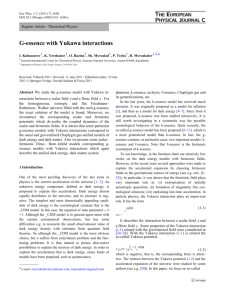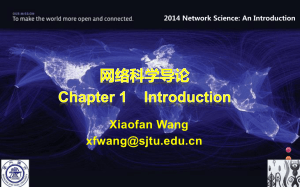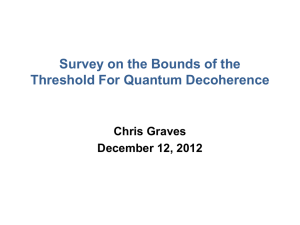lett constant

G-essence cosmologies with scalar-fermion interactions
Olga Razina
1
, Yerlan Myrzakulov
1
, Nurzhan Serikbayev
1
Gulgasyl Nugmanova
1
, Shynaray Myrzakul
1
and Ratbay Myrzakulov
1,2 ∗
,
1
Eurasian International Center for Theoretical Physics,
Eurasian National University, Astana 010008, Kazakhstan
2
Department of Physics, CSU Fresno, Fresno, CA 93740 USA
PACS numbers: 95.30.Sf; 95.36.+x;98.80.Jk; 04.50.Kd.
A
BSTRACT
We study the two particular models of g-essence with Yukawa type interactions between a scalar field φ and a classical Dirac field ψ . For the homogeneous, isotropic and flat Friedmann-
Robertson-Walker universe filled with the such g-essence, some exact solutions of these models are found. Moreover, we reconstruct the corresponding scalar and fermionic potentials.
1 Introduction
The recent data from type Ia supernovae and cosmic microwave background radiation and so on [1]-[2] have provided strong evidences for a spatially flat and accelerated expanding universe at the present time. This accelerated expansion of the universe is attributed to the domination of a component with negative pressure, called dark energy. So far, the nature of dark energy remains a mystery. In the literature, plenty of dark energy candidates has been proposed. Among of which are quintessence (w > − 1), phantom (w < − 1), k-essence (w
>
−
1 or w <
−
1), quintom (w crosses
−
1), etc. Note that the accelerated expansion of the universe can also be obtained by the modified gravity theories like F (R), F (G), F (T ), F (R, T ) and so on (see e.g. [3]). As is well-known, the simplest model of dark energy is the cosmological constant with energy density being near the vacuum energy ρ
Λ
≈
(10
− 3 eV )
4
withoud varying with time. However, this cosmological constant model of dark energy suffers from the severe problem of fine-tuning and coincidence.
One of interesting models of dark energy is the k-essence [4]-[6] (see also [7]-[8]). Recently it is proposed the another model of dark energy - the so-called f-essence [9] which is the fermionic counterpart of the k-essence. Also it is proposed the g-essence which is some hybrid construction of k-essence and f-essence (see e.g. [9]-[12]).
To our knowledge, in the literature there are relatively few works on the dark energy models with scalar and fermionic fields and with
Yukawa type interactions (see e.g. refs. [14]-[18]). In this paper, we study the g-essence cosmologies with Yukawa type interactions.
∗
The corresponding author. Email: rmyrzakulov@gmail.com; rmyrzakulov@csufresno.edu
1
This paper is organized as follows. In Section 2, we simply review the basic informations of g-essence in the Friedmann-Robertson-
Walker (FRW) universe. In Section 3, we present the particular model of g-essence with the Yukawa interactions and construct its exact solution. In Section 4, we introduce the more general particular model of g-essence and present its two exact solutions. Section 5 is the conclusion of the paper.
2 G-essence
The action of g-essence has the form [9]
X = 0.5g
S =
Z
d
4 x
√
− g
∇
µ
φ ∇
ν
φ, Y = 0.5i[ψ
[R + 2K(X, Y, φ, ψ, ψ where K is some function of its arguments, φ is a scalar function, ψ = (ψ 1 , ψ 2 , ψ 3 , ψ 4 )
T fermionic function and ψ = ψ
¯
+
γ
0
µν is its adjoint function. Here
¯
µ
¯
)],
¯ µ
D
µ
ψ
−
(D
µ
ψ) ψ]
(2.1) is a
(2.2) are the canonical kinetic terms for the scalar and fermionic fields, respectively.
∇
µ
and D
µ
are the covariant derivatives. Note that the fermionic fields are treated here as classically commuting fields. The model (2.1) admits important two reductions: k-essence and f-essence .
We now consider the homogeneous, isotropic and flat FRW universe filled with g-essence. In this case, the metric reads ds
2
= dt
2
− a
2
(dx
2
+ dy
2
+ dz
2
) and the vierbein is chosen to be (see e.g. [13])
(2.3)
(e a
µ
) = diag(1, 1/a, 1/a, 1/a), (e
µ a
) = diag(1, a, a, a).
[9]
In the case of the FRW metric (2.3), the equations corresponding to the action (2.1) look like
(2.4)
˙
K
Y
ψ + 0.5(3HK
Y
˙
+ K
Y
)ψ
−
iγ
¨
K
Y
ψ + 0.5(3HK
Y
+ K
Y
)ψ + iK
ψ
γ
˙
˙
2H + 3H
3H
2
2
− ρ = 0,
˙
+ p = 0,
K
X
φ + (K
X
+ 3HK
X
)φ − K
φ
0
= 0,
˙
K
ψ
¯ = 0,
˙ ¯
0
= 0,
ρ˙ + 3H(ρ + p) = 0, where the kinetic terms, the energy density and the pressure take the form
¯ 0 ˙
¯
˙
0
˙ 2
X = 0.5φ , Y = 0.5i(ψγ ψ
−
ψγ ψ) and
ρ = 2XK
X
+ Y K
Y
−
K, p = K.
3 Model with Yukawa interactions
In this paper, we consider the g-essence action (2.1) with
(2.5)
(2.6)
(2.7)
(2.8)
(2.9)
(2.10)
(2.11)
(2.12)
K = X + Y
−
V 1 (φ)
−
V 2 (u)
−
ηφu,
2
(3.1)
¯ where η = const, u = ψψ . Then the system (2.5)-(2.10) takes the form
˙
3 H
2 H + 3 H
2
¨
2
− ρ
= 0 ,
+ p = 0 ,
˙
˙
˙
3
ψ
+
φ + 3 Hφ + ηu − V
1 φ
′
= 0 ,
0 0
2
Hψ
+ iV 2
γ
ψ
+ iηγ
ψφ
= 0 ,
3
′
0 0
ψ + 2
Hψ − iV
2
ψγ − iηφψγ
ρ ˙ + 3 H ( ρ + p ) = 0 ,
= 0 ,
(3.6)
(3.7) where
ρ =
˙
2
0 .
5
φ
˙
2
′
+ V 1 + ηφu + V 2 , p = 0 .
5
φ − V
1
− V
2 + V
2
u.
(3.8)
(3.9)
Let us now we show that the system (3.2)-(3.7) admits the exact analytical solutions. To do it, we will use the methods e.g. of [19]-[21]. In fact, for example, it has the following particular solution
(3.2)
(3.3)
(3.4)
(3.5) a
= a
0 t
λ
,
φ = φ
0 t
2−3 λ
ψ l
=
0 a
1 .
5 t c k
1 .
5 λ
, c l e
− iD , ( l = 1 , 2) ,
ψ k
= a
1 .
5 t e iD
1 .
5 λ
, ( k = 3 , 4) ,
0
ηc where c j
obey the following condition c = |c 1 |
2
+ |c 2 |
2
| − |c
3 |
2
− |c
4 |
2
, φ
0 = −
2
λa 3
D = − c (3
λ
0
−
3 λ −1
1) t
+
3 a
3
0
(1
η
2 c
−
λ
) t
3(1− λ )
+ D
0
, D 0 = const.
a 0
3 (2−3
λ )
The corresponding potentials take the form and
(3.10)
(3.11)
(3.12)
(3.13)
(3.14) where V
V
1 ( φ )
=
V
2 ( u )
= 3 λ 2
φ
0
2
δ
2
( δ
−
1 + 3 λ ) φ 2(
δ
δ
−1)
+
φ δηc
0
φ
2(
δ
1)
φ a 3 (
δ
3
λ
)
φ ua
3
−
0 0
−
0 c
0
2
3 λ
+
3 φ 2 δ 2 λ
0
(
δ
3
λ
) c
−
0
− c c
−1)
2(
δ
1) c ua
0
3
−
2( δ
+
3 λ
3
ληφ c
0 a
3
δ
−3
δ
λ
+ V
10
, ua
3
−
0
10
= const, the deceleration parameters take the form
δ = 2 − 3 λ, u = a 3
= a
0
3 t
3 λ
δ
−3
λ
3 λ
− V
10
(3.15)
, (3.16)
. For this solution, the equation of state and w =
−
1 +
2
, q =
1 − λ
.
3
λ λ
(3.17)
So we conclude that, in the case of the solution, the g-essence model (2.1) with (3.1) can describes the accelerated expansion of the universe.
4 General model with Yukawa type interactions
In this section, we consider the g-essence action (2.1) with
K = ǫX + σY − V
1 ( φ ) − V
2 ( u ) − ηU
1 ( φ ) U 2 ( u ) ,
3
(4.1)
where ǫ
and
σ
are some constants. Here we can note that ǫ
= 1 ( ǫ
=
−
1) corresponds to the usual (phantom) case. Then the system (2.9)-(2.14) takes the form
¨
˙
3 H
2
2 H + 3 H
2
− ρ = 0 ,
˙
+ p = 0 ,
˙
σψ
+
˙
3
3
′ ǫφ + 3 ǫHφ + ηU
2 U 1
φ
− V
1
φ
2
σHψ
+ iV
2
γ
0
′
′ ′
0 0
= 0 ,
0
ψ
+ iηU
1
U
2
γ ψ
= 0 ,
σψ
+ 2
σHψ − iV
2
ψγ − iηU
1
U
2
ψγ
= 0 ,
ρ ˙ + 3 H ( ρ + p ) = 0 ,
(4.2)
(4.3)
(4.4)
(4.5)
(4.6)
(4.7) where
ρ =
˙
2
0 .
5 ǫφ
˙ p
= 0 .
5 ǫφ
+ V
1 + ηU
1
U
2 + V
2
2
′
− V
1
− V
2 + V
2
u.
,
As in the previous case, we can construct the exact analytical solutions of the system (4.2)-(4.7). i) As an example, here we present the following particular solution
(4.8)
(4.9) a = a
0 t
λ
,
φ
= φ
0 t
δ
,
ψ l
= c l a
1 .
5 e t
1 .
5 λ
− iD , ( l = 1 , 2) ,
0
ψ k
= c k a
1 .
5 t
1 .
5 λ e iD
, ( k = 3 , 4) ,
0 where c j
obey the following condition c = |c
1
|
2
+ |c
2
|
2
| − |c
3
|
2
− |c
4
|
2
, φ
0 = −
ηc a 0
3
(2−3
λ ) and
(4.10)
(4.11)
(4.12)
(4.13)
D
= i
σ c (3 λ
−
In this case, the corresponding potentials look like
−
1 + n
λ t n + l +3 λ +1 + D 0 ) .
V (
φ
) = ǫφ
0
2
δ
2
( δ − 1 + 3 λ )(2 δ + 1 + 3 λ )
2( δ
−1)
φ
δ
+ V ,
V (
2
1 u ) =
U ( φ ) =
3 λ
2
2( δ − 1)(4( δ − 1) − n + 3 λ ) ua 0
3 c
2
2 ǫφ
0
3 λ +
2 δ 2
(
3 ǫφ
0
2 δ 2
2( δ
−
δ −
1 + 3
λ
)
−
φ
1
−
ηU
(4( δ 1) n + 3 λ )
λ (2( δ
1)(4(
φ
δ
−
1)
1)
φ
0
− n − n + 3 λ )
3 λ )
10
− 2( δ
−1) ua 0
3 c
3 λ
V ,
− 10
2( δ −1)− n
−
δ
,
20 − n ua
3
0
−
− 0
3 λ
(4.14)
(4.15)
(4.16)
(4.17)
U
2 ( u )
=
U
20 c where V
10 = const, δ
= 2
−
3
λ, and the deceleration parameters for this solution. We have
, c c u = a
3
= a
0
3 t
3 λ . Also we can present the equation of state
(4.18) w =
−
1 +
2
, q =
1 −
3 λ
λ
λ
.
(4.19)
So for this solution, the g-essence model (2.1) with (4.1) also can describes the accelerated expansion of the universe for some values of λ .
4
ii) As the second, let us consider the de Sitter like solution. It reads as a = a 0 e
βt
,
φ = φ
0 e
κt
,
ψ l
= c l a
1 .
5 e
1 .
5 βt
e
− iD , (l = 1, 2),
0
ψ k
= c k a
1 .
5 e
1 .
5 βt e iD
, (k = 3, 4),
0
(4.20)
(4.21)
(4.22)
(4.23) where c j
obey the following condition c = |c 1 |
2
+ |c 2 |
2
| − |c
3 |
2
− |c
4 |
2
and i ǫa
0
3
φ
0
2
κ
2
κ β
+3 t
ηa
0
3
U 10 U 20 n l n β t
+ +3 )
D = σ c(2κ + 3β)
e
(2 + c(l + n + 3β)
For the potentials we obtain the following expressions
1 + 3β
e
( + D 0
.
V
1
(φ)
V 2 (u)
U 1
(φ)
U 2 (u) ǫφ
2
0
κ(κ + 3β)(n + 3β) φ
2
=
=
2(4κ − n + 3β)
2ǫφ 2 κ 2 (κ + 3β)
0
− n + 3β)
φ
φ
0
+ V
10
,
2 κ
3ǫφ
0
2
κβ(2κ − n − 3β)
2(4κ ua 0
3
−
3 β c
V
+ 3β
−
10
2 κ − n
κ
2
,
= − ηU
20
(4κ − n + 3β) ua
3
0
−
3 n
λ
φ
0
,
= U
20 c ,
(4.24)
(4.25)
(4.26)
(4.27)
(4.28) where V 10 , n = consts. In this case, the equation of state and the deceleration parameters take the form w = q = −1 that is we have the de Sitter spacetime.
5 Conclusion
In this paper, we have studied two particular cases of g-essence with the Yukawa type interactions between the scalar and the fermion fields. We constructed some examples of exact analytical so-lutions of these models. The corresponding scalar and fermionic potentials are presented. These results show that the g-essence with the Yukawa interactions can describes the accelerated ex-pansions of the universe. Finally we would like to note that, quite recently, the models with the classical fermionic fields were studied also in [22]-[23].
References
[1] Perlmutter S. et al. Measurements of omega and lambda from 42 high-redshift supernovae , Astrophys. J. 517, 565-586 (1999) [astro-ph/9812133].
[2] Riess et al. Observational evidence from supernovae for an accelerating universe and a cos-mological constant , Astron. J.
116, 1009-1038 (1998) [astro-ph/9805201].
[3] Momeni D., Jamil M., Myrzakulov R. Dust f(R,T) Models , [arXiv:1107.5807].
[4] Armendariz-Picon C., Damour T., Mukhanov V.F. k-inflation , Phys. Lett. B458, 209-218
(1999) [hep-th/9904075].
[5] Armendariz-Picon C., Mukhanov V.F., Steinhardt P.J. Essentials of k-essence , Phys.
Rev. D63, 103510 (2001) [astro-ph/0006373].
[6] Armendariz-Picon C., Mukhanov V.F., Steinhardt P.J. A dynamical solution to the problem of a small cosmological constant and late-time cosmic acceleration , Phys.
Rev. Lett.
85, 4438-4441 (2000) [astro-ph/0004134].
5
[7] De Putter R., Linder E.V. Kinetic k-essence and Quintessence, Astropart. Phys. 28 , 263-272 (2007), [arXiv:0705.0400]
[8] Tsyba P.Y., Kulnazarov I.I., Yerzhanov K.K., Myrzakulov R. Pure kinetic k-essence as the cosmic speed-up, Inter. J. Theor. Phys., 50 , 1876-1886 (2011) [arXiv:1008.0779]
[9] Myrzakulov R. Fermionic k-essence, [arXiv:1011.4337]
[10] Yerzhanov K. K., Myrzakulov R. et al. Accelerated expansion of the Universe driven by G-essence, [arXiv:1012.3031]
[11] Kulnazarov I., Yerzhanov K., Razina O., Myrzakul Sh., Tsyba P., Myrzakulov R. G-essence with Yukawa Interactions, Eur. Phys. J. C, 71 , 1698 (2011) [arXiv:1012.4669]
[12] Razina O., Myrzakulov R. et al. Einstein-Cartan gravity and G-essence, [arXiv:1012.5690]
[13] Armendariz-Picon C., Greene P. Spinors, Inflation, and Non-Singular Cyclic Cosmologies, Gen. Relativ. Gravit. 35 , 1637-1658 (2003), [arXiv:hep-th/0301129]
[14] Zanusso O., Zambelli L., Vacca G.P., Percacci R. Gravitational corrections to Yukawa systems, [arXiv:0904.0938]
[15] Rodigast A., Schuster T. Gravitational Corrections to Yukawa and ϕ
4
Interactions, [arXiv:0908.2422]
[16] Loeb A., Weiner N. Cores in Dwarf Galaxies from Dark Matter with a Yukawa Potential, [arXiv:1011.6374]
[17] Miao S.P., Woodard R.P. Leading Log Solution for Inflationary Yukawa, [gr-qc/0602110]
[18] Woodard R.P. Generalizing Starobinskii’s Formalism to Yukawa Theory & to Scalar QED, [gr-qc/0608037]
[19] Nojiri S., Odintsov S.D. Unified cosmic history in modified gravity: from F(R) theory to Lorentz non-invariant models, Physics Reports, 2011 [arXiv:1011.0544]
[20] Myrzakulov R., Saez-Gomez D., Tureanu A. On the ΛCDM Universe in f ( G ) gravity, Gen. Rel. Grav., 43 , 1671-1684 (2011)
[arXiv:1009.0902]
[21] Elizalde E., Myrzakulov R., Obukhov V.V., Saez-Gomez D. LambdaCDM epoch reconstruction from F(R,G) and modified Gauss-
Bonnet gravities, Class. Quant. Grav., 27 , 095007 (2010) [arXiv:1001.3636]
[22] Ribas M.O., Devecchi F.P., Kremer G.M. Fermionic cosmologies with Yukawa type interac-tions, Europhys. Lett., 93 , 19002 (2011)[arXiv:1012.5557]
[23] Cataldo M., Chimento L. Crossing the phantom divide with a classical Dirac field, Astrophys. Space Sci., 332 , 455-461 (2011) [arXiv:11001.0281]
[24] Myrzakul Sh., Esmakhanova k., Myrzakulov K., Nugmanova G., Myrzakulov R. FRW cosmological models with integrable and nonintegrable differential equations of state, [arXiv:1105.2771]
[25] Nugmanova G.N., Myrzakul Sh.R., Razina O.V., Esmakhanova K.R., Serikbayev N.S., Myrza-kulov R.Some cosmological aspects of
Horava-Lifshitz gravity: integrable and nonintegrable models, [arXiv:1104.5374]
[26] Esmakhanova K., Myrzakulov N., Nugmanova G., Myrzakulov Y., Chechin L., Myrzakulov R. Dark energy in some integrable and nonintegrable FRW cosmological models, IJMPD, v.20, N11, (2011), [arXiv:1104.3705]
6






